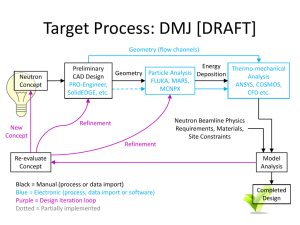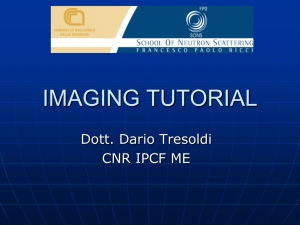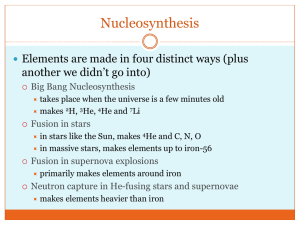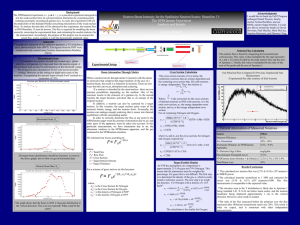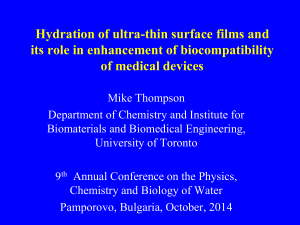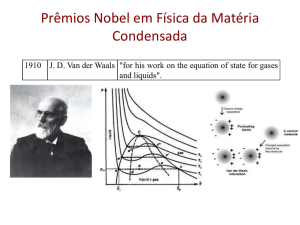The Neutron Spin - The RM Santilli Foundation
advertisement
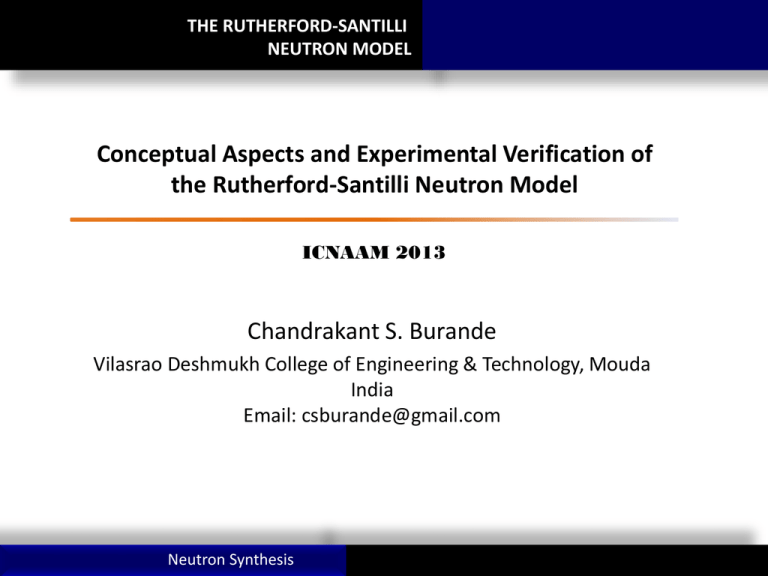
THE RUTHERFORD-SANTILLI NEUTRON MODEL Conceptual Aspects and Experimental Verification of the Rutherford-Santilli Neutron Model ICNAAM 2013 Chandrakant S. Burande Vilasrao Deshmukh College of Engineering & Technology, Mouda India Email: csburande@gmail.com Neutron Synthesis THE RUTHERFORD-SANTILLI NEUTRON MODEL ACKNOWLEDGEMENTS The author is highly grateful to Professor R. M. Santilli, Prof. Anderson and Prof. C. Corda for giving an opportunity to present this paper in ICNAAM-2013. The financial support from the R. M. Santilli Foundation is gratefully acknowledged. The author is also highly indebted to Prof. R. M. Santilli and Professor A. A. Bhalekar for suggesting me this topic and helping me in writing this paper by their valuable advices and suggestions in its overall improvement. Neutron Synthesis Chandrakant S. Burande, VDCET, Mouda, India THE RUTHERFORD-SANTILLI NEUTRON MODEL Contents Rutherford’s Conjecture Neutrino Hypothesis Neutrino Controversies Hadronic Mechanics Neutron Spin Neutron Magnetic Moment Neutron Synthesis Chandrakant S. Burande, VDCET, Mouda, India THE RUTHERFORD-SANTILLI NEUTRON MODEL Rutherford’s Conjecture Rutherford’s Conjecture In 1920 H. Rutherford [1] conjectured that neutron is a compressed hydrogen atom in the core of the stars and claimed that first particle synthesized in stars is neutron from a proton and an electron after which all known matter is progressively synthesized. Accordingly, p e n p e In 1932, the existence of the neutron was confirmed by Chadwick [2]. QE [1] H. Rutherford, Proc. Roy. Soc. A, Vol. 97, 374 (1920). [2] J. Chadwick, Proc. Roy. Soc. A, Vol. 136, 692 (1932). Neutron Synthesis Chandrakant S. Burande, VDCET, Mouda, India THE RUTHERFORD-SANTILLI NEUTRON MODEL Neutrino Hypothesis Pauli’s Objection Pauli [3] noted that the spin 1/2 of the neutron cannot be represented via a quantum state of proton and electron, each having spin 1/2. p e n 1 2 12 0 or p or 12 e n 12 1 Fermi’s Proposal In order resolve Pauli's objection, Fermi [4] developed the theory of weak interactions and proposed the emission of a neutral and massless particle, named neutrino. p e n or p e n 12 1 2 12 1 2 or 12 1 2 12 12 [3] W. Pauli, Handbuch der Physik, Vol. 24, Berlin, Springer Verlag, 1933. [4] E. Fermi, Nuclear Physics, Chicago, University of Chicago Press, 1949. Neutron Synthesis Chandrakant S. Burande, VDCET, Mouda, India THE RUTHERFORD-SANTILLI NEUTRON MODEL Santilli’s Observations Neutrino Controversies However, Santilli [5] has dismissed the Fermi’s version of synthesis of neutron on following reasons: The sum of the rest energies of the proton and of the electron, is smaller than the rest energy of the neutron by margin of 0.782 Mev. mp me mn 938.272 0.511 939.565 Antineutrino cannot deliver the 0.782 MeV needed for the neutron synthesis because the cross section of former with electron or proton is null. Till date, proton and electron are the only experimentally discovered stable massive particles. Hence, emission of neutrino in neutron formation is irrelevant, it cannot be directly detected. [5] R. M. Santilli, Hadronic Mathematics, Mechanics and Chemistry, Volume I-V, Palm Harbor, U.S.A., International Academic Press, 2008. Neutron Synthesis Chandrakant S. Burande, VDCET, Mouda, India THE RUTHERFORD-SANTILLI NEUTRON MODEL Limitation of QM limitation of QM Schrödinger equation p p m z e2 r r E r does not admit positive binding energy for quantum bound states when electron totally immersed within the hyper-dense medium inside the proton structure at distances of the order 10-13 cm. For example mass defect in nuclear fusion. Quantum Mechanics bound state of p & e is the hydrogen atom, with smallest orbit of the order of 10-8 cm (Bohr orbit). Santilli ‘s hadronic mechanics has identified the bound state when the electron orbits within the proton structure at distances of the order of or less 10-13 cm. The mutual overlapping of the charge distribution or wavepackets of electron and proton leads new interactions of contact type. In this situation quantum mechanics fails to represent nonlocal integral interactions and Non- Hamiltonian Potential. Neutron Synthesis Chandrakant S. Burande, VDCET, Mouda, India THE RUTHERFORD-SANTILLI NEUTRON MODEL Hadronic State Hydrogen Atom 10-8 cm Quantum Mechanics Bound state e p p e Energy Level Bound state identified by Hadronic Mechanics Mutual Distance 10-13 cm Neutron The conventional quantum state is recovered when the electron leaves the proton structure . Thus hadronic state is one and only one, the neutron. Hence, energy levels of the hydrogen atom are the excited states of the neutron. Neutron Synthesis Chandrakant S. Burande, VDCET, Mouda, India THE RUTHERFORD-SANTILLI NEUTRON MODEL Hadronic Energy Hadronic Mechanics In this event, Santilli isomechanics is ideally suited for a quantitative study of the neutron synthesis because, in addition to all interactions characterizing the hydrogen atom, allows the new interactions caused by deep mutual penetration of the constituents. The method has been used by Santilli in numerous applications. Santilli [6] obtained an isoequation for the neutron by isotopically lifting of Schrödinger equation introducing additional potential term of Coulomb nature that reads as, 2 2 z e e 1 ˆ pˆ Tˆ ˆ ˆ r E ˆ r ˆ p T T m r r with isounit Iˆ U I U † 1 Tˆ 0 [6] R. M. Santilli, “Apparent Consistency of Rutherford’s Hypothesis on Neutron as a Compressed Hydrogen Atom”, Hadronic J. Vol. 13, 513-531 (1990). Neutron Synthesis Chandrakant S. Burande, VDCET, Mouda, India THE RUTHERFORD-SANTILLI NEUTRON MODEL Hadronic Energy Iˆ Diag n12 1 , n22 1 , n32 1 , n42 1 Diag n 2 , n 2 , n 2 , n 2 e 2 1 2 2 2 3 2 4 ˆ dr 3ˆ † r 1 ˆ r 2 the two diagonal matrices represent the shapes (assumed to be spheroids) and the densities of the particle. considered, while the last term represents the non-Hamiltonian interactions. Clearly, this mutual penetration cannot be represented with a Hamiltonian for because it does not hold the nonlocal-differential topology. However, the same interactions can be readily represented with Santilli’s isounit as it indeed nonlocal-integral. Neutron Synthesis Chandrakant S. Burande, VDCET, Mouda, India THE RUTHERFORD-SANTILLI NEUTRON MODEL Hadronic Energy For spherical point-like charge particle, such as electrons, the diagonal matrices are reduces to 1. The evaluation of the volume integral into a constant, Iˆ Diag n12 1 , n22 1 , n32 1 , n42 1 Diag n 2 , n 2 , n 2 , n 2 e 2 1 2 2 2 3 2 4 ˆ dr 3ˆ † r 1 ˆ r 2 N dr 3ˆ † r 1 ˆ r 2 Iˆ eN ˆ 1 N ˆ Iˆ Tˆ e N ˆ 1 N ˆ , 1, Tˆ P ebr , 1, rlim Iˆ 1 1 fm ˆ Q 1 ebr r where P and Q are constants and b is inverse of hadronic horizon, rh . Neutron Synthesis Chandrakant S. Burande, VDCET, Mouda, India THE RUTHERFORD-SANTILLI NEUTRON MODEL Hadronic Energy The isotopic element now becomes Tˆ e N ˆ VHulthen e b r ˆ 1 N 1 V0 1 , b r r 1 e r VHulthen e b r V0 1 e b r VHulthen is the Hulthen potential and V0 is Hulthen's constant. The Hulthen potential at small distances behaves like the Coulomb potential, VHulthen Neutron Synthesis V0 1 b r Chandrakant S. Burande, VDCET, Mouda, India THE RUTHERFORD-SANTILLI NEUTRON MODEL Hadronic Energy Using above equations, Santilli obtained the nonrelativistic radial equation of the hadronic two-body structure model that reads as 1 d 2 d m r 2 2 r dr dr e b r Ehb V0 ˆ r 0 2 b r 1 e where Ehb hadronic binding energy. br Assuming the change of variable, x 1 e equation is given by the Jacobi polynomials, n Gn x 1 k 1 A k 1 12 n 1 n k 2 A 1 k x k k 1 k2 E mE 0, 2 2 b V0 Neutron Synthesis the solution of the above k2 mV0 . 2 2 b Chandrakant S. Burande, VDCET, Mouda, India THE RUTHERFORD-SANTILLI NEUTRON MODEL Hadronic Energy The hadronic binding energy then acquires the typical spectrum of Hulthen’s potential V 0 4k2 Ehb E Bind 2 k 2 n . n The only admissible states are therefore are those for which, k2 n2 and n 1 the santilli-Schrodinger equation gives following isonormalized isoeigen function 2 A 1/ 2 3 ˆ r (3) 2 A 1/ 2 br 1 e e A r 1/2 br . An isoparticle to be bounded inside the hadronic horizon, b 1 , its isowavelength () must be proportional to the horizon itself and this gives 2 k1b Neutron Synthesis 1 Chandrakant S. Burande, VDCET, Mouda, India THE RUTHERFORD-SANTILLI NEUTRON MODEL Hadronic Energy where k1 is a positive quantity that must be constant for a stationary state. Using above equations, Santilli obtained the following expression for the hadronic total energy of the hadronic bound state, 2 Eht 2 Ehr 2 Ehk Ehb 2k1 1 k2 1 bc0 . The total energy of the two-body hadronic bound state depends on two unknown constants, k1and k2. To achieve a numerical solution of total energy of hadronic state, Santilli considered the mean life of the hadron, 2 2 Ehk 1 2 ˆ 0 where α is the fine structure constant and the mean-life is isotopic, that is derived via isotopic methods. The mean-life of hadronic bound state then becomes 3 k 1 4 1 2 bc0 . 2 48 137 Neutron Synthesis k1 Chandrakant S. Burande, VDCET, Mouda, India THE RUTHERFORD-SANTILLI NEUTRON MODEL Comparing above equations, give k 1 2 k1 Hadronic Energy 3 48 137 2 4 bc0 1 The numerical solution of unknown constants and are obtained by Santilli, k1 2.6, k2 1 0.81108 1 Thus, the hadronic binding energy for admitted level, n 1 Ehb E Bind V 0 4 k2 2 k 2 n 0, n is insignificantly small and hence can be neglected. Neutron Synthesis Chandrakant S. Burande, VDCET, Mouda, India THE RUTHERFORD-SANTILLI NEUTRON MODEL Hadronic Energy The hadronic kinetic energy within the hadronic horizon is equally insignificant, that is Ehk k1 bc0 6.63 1023 MeV In this event, the total hadronic energy of the neutron is primarily characterized by the rest energy of the proton and the isonormalized rest energy of the isoelectron, En E p Ehr ,eˆ E p me c0 2 2 938.272 1.294 939.568MeV 2 0.3949 is a geometrization of the departure of the interior of hadrons from our space-time. Hence, calculated rest energy of isoelectronium is numerically identical to experimentally determined rest energy of neutron. Neutron Synthesis Chandrakant S. Burande, VDCET, Mouda, India THE RUTHERFORD-SANTILLI NEUTRON MODEL Neutron Spin The Neutron Spin A general law of hadronic mechanics is that only the singlet coupling of spinning particles at mutual distances of the order of 10-13cm, their size is stable, while triplet couplings are highly unstable (Santilli illustrated this fact with famous Gear Model: Gears can only be coupled in singlet). Neutron Synthesis Chandrakant S. Burande, VDCET, Mouda, India THE RUTHERFORD-SANTILLI NEUTRON MODEL Neutron Spin The Neutron Spin For parallel spin (triplet state) is discarded by hadronic mechanics at mutual distances of the order of 10-13cm, are highly unstable (Santilli illustrated this fact with famous Gear Model: Gears can only be coupled in singlet). Neutron Synthesis Chandrakant S. Burande, VDCET, Mouda, India Neutron Spin THE RUTHERFORD-SANTILLI NEUTRON MODEL Neutron Spin In neutron the spin of the proton is equal but opposite to that of the electron spin. Thus, the resulting spin is zero for singlet state. However, observed spin of the neutron is ½. The interpretation of the spin ½ of the neutron was for the first successfully explained by Santilli. Considering the initiation of Rutherford’s process penetration of the electron within hyperdense medium inside the proton. As soon as the penetration begins, the isoelectron is trapped inside the hyperdense medium inside the proton, thus resulting in a constrained orbital motion of the isoelectron that must coincide with the proton spin. Under this circumstance, it is then evident that the isoelectron is constrained to have an orbital angular momentum ½, the total angular momentum of the isoelectron is null and the spin of the neutron coincides with that of the proton. Sn S p Se M e 1 2 1 2 1 2 Neutron Synthesis Chandrakant S. Burande, VDCET, Mouda, India THE RUTHERFORD-SANTILLI NEUTRON MODEL Neutron Spin sp le se Sn S p Se M e 1 2 1 2 1 2 Neutron Synthesis Chandrakant S. Burande, VDCET, Mouda, India THE RUTHERFORD-SANTILLI NEUTRON MODEL Neutron Spin The actual mathematical representation of the above structure was obtained by Santilli. It requires isotopically lifting of the quantum mechanical spin that, in turn, required the prior isotopic lifting of Lie's theory and its underlying mathematics. Note that the proton is not mutated because it is 2000 times heavier than the electron, and that the coupling must be in singlet for stability. This implies that, for the case of the neutron structure, the spin of the electron is also not mutated. However, the angular momentum of electron is mutated inside the hadronic sphere. The needed mutation of the quantum into the hadronic angular momentum is trivially given by the nonunitary transforms 1 U U † Iˆ , Tˆ 2, 2 Neutron Synthesis Chandrakant S. Burande, VDCET, Mouda, India THE RUTHERFORD-SANTILLI NEUTRON MODEL Neutron Spin The mutation is supported by the isotopic invariance of the Hilbert space. Nonunitary lifting of angular momentum, in this case, reads 1 ˆ 2 Lˆ3 2 lˆ, m ˆ . l , m L3 l , m 1 U l , m L3 l , m U † lˆ, m 2 Santilli applied irregular isorepresentations of Lie-Santilli isoalgebras [7] for the representation of the spin of the neutron. Isorepresentations characterized by nonunitary isounitary transforms for the generators different than those for the product. In this case, Santilli has selected the following two-dimensional irregular isorepresentation of SU 2 1 g 0 g 0 11 ˆ Iˆ 11 , T 1 0 g 0 g 22 22 1 0 ˆ J1 1 2 2 g22 g111 2 , 0 1 2 0 i g 1 11 ˆ J2 2 i g22 1 2 0 [7] R. M. Santilli, Lie-admissible Approach to the Hadronic Structure, Volume I: Non-applicability of the Galilei and Einstein Relativities in the series Monographs in Theoretical Physics, Hadronic Press, Palm Harbor, Florida, 1978. Neutron Synthesis Chandrakant S. Burande, VDCET, Mouda, India THE RUTHERFORD-SANTILLI NEUTRON MODEL 1 1 2 ˆ J3 2 2 Jˆ , Jˆ i Jˆ , 2 3 1 g111 0 , 1 0 g22 Neutron Spin Det Iˆ g11 g 22 Jˆ , Jˆ i 1 2 Jˆ , Jˆ , Jˆ 1 1 2 Jˆ 3 1 2 2 2 3 2 Jˆ2 ˆ ˆj , sˆ Jˆk Tˆ Jˆk Tˆ ˆj , sˆ ˆj , sˆ 3 Jˆ3 ˆ ˆj, sˆ Jˆ3 Tˆ ˆj, sˆ ˆj, sˆ 2 Santilli then computed the total angular momentum of the neutron model, k 3 k 1 2 n p , eˆ hm 1 int rinsic ˆ J n J p Lˆorbital J eˆ eˆ 2 2 1 2 resulting in the values anticipated above, namely: , 1. Hadronic Mechanics Chandrakant S. Burande, VDCET, Mouda, India THE RUTHERFORD-SANTILLI The Neutron Magnetic Moment NEUTRON MODEL Neutron Spin The quantum representation of the anomalous magnetic moment of the neutron, is impossible from known magnetic moments of proton, and electron, because quantum mechanics does not admit an orbital motion of the electron inside the proton. By contrast when the hadronic orbital motion is admitted, the magnetic moment of the neutron is generated by the following three contributions, n 1.9 n int rinsic p orbital int rinsic e e e e e 2.7 4.6 , 2 m c 2 m c 2 m c p o p o p o From above equations, Santilli derived the desired value tot orbital e e int rinsic e 4.6 e 2.5 10 , 2 m c 3 e p orbital e Hadronic Mechanics 1 2.5 10 3 o . e Chandrakant S. Burande, VDCET, Mouda, India THE RUTHERFORD-SANTILLI The Neutron Magnetic Moment NEUTRON MODEL Experimental Verification of the Rutherford-Santilli Neutron Model Don Borghi’s experiment on synthesis of neutrons Santilli experiment on the synthesis of neutrons Santilli’s Aetherino Hypothesis The Don Borghi-Santilli Neutroid Interpretation of Don Borghi-Santilli Experiment Hadronic Mechanics Chandrakant S. Burande, VDCET, Mouda, India THE RUTHERFORD-SANTILLI NEUTRON MODEL Don Borghi experiment on the synthesis of neutrons Don Borghi’s experiment on synthesis of neutrons The first experiment on the synthesis of neutrons from protons and electrons was conducted by Carlo Borghi, C. Giori and A. Dall’Olio in the 1960s at the CEN Laboratories in Recife, Brazil [8]. Hydrogen gas at pressure of 1 bar was obtained from the electrolytical separation of water and was placed in the interior of a cylindrical metal chamber. Hydrogen gas kept ionized by an electric arc with about 500 V and 10 mA. Suitable materials which are vulnerable to nuclear transmutation when exposed to a neutron flux, were placed exterior of the chamber. [8] C. Borghi, C. Giori C. and A. Dall’Olio, Communications of CENUFPE, Number 8 (1969) and 25 (1971). Hadronic Mechanics Chandrakant S. Burande, VDCET, Mouda, India THE RUTHERFORD-SANTILLI NEUTRON MODEL Don Borghi experiment on the synthesis of neutrons Following exposures of the order of days or weeks, the experimentalists reported nuclear transmutations that were based on the observed neutron count of up to 104 cps. Don Borghi experiment has been strongly criticized by academia on pure theoretical grounds without the actual repetition of the tests. Note that experiment makes no claim of direct detection of neutrons, and only claims the detection of clear nuclear transmutations. To verify the claim of Don Borghi’s experiment, Santilli repeated this experiment in large number of laboratories and institutions the world over. Hadronic Mechanics Chandrakant S. Burande, VDCET, Mouda, India THE RUTHERFORD-SANTILLI NEUTRON MODEL Santilli experiment on the synthesis of neutrons Santilli experiment on the synthesis of neutrons Santilli conceived his experiment [9] as being solely based on the use of an electric arc within a cold (i.e., at atmospheric temperature) hydrogen gas without any use of microwave at all. Hadronic Mechanics Chandrakant S. Burande, VDCET, Mouda, India THE RUTHERFORD-SANTILLI NEUTRON MODEL Santilli experiment on the synthesis of neutrons Three different klystrons were manufactured, tested and used for the measurements. The specifications of detectors were used for measurements are given below: A detector model PM1703GN manufactured by Polimaster, Inc., with sonic and vibration alarms as well as memory for printouts, with the photon channel activated by CsI and the neutron channel activated by LiI. A photon-neutron detector SAM 935 manufactured by Berkeley Nucleonics, Inc., with the photon channel activated by NaI and the neutron channel activated by He-3 also equipped with sonic alarm and memory for printouts of all counts. This detector was used to verify the counts from the preceding one. A BF3 activated neutron detector model 12-4 manufactured by Ludlum Measurements, Inc., without counts memory for printouts. This detector was used to verify the counts by the preceding two detectors. Electric arcs were powered by welders manufactured by Miller Electric, Inc., including a Syncrowave 300, a Dynasty 200, and a Dynasty 700 capable of delivering an arc in DC or AC mode, the latter having frequencies variable from 20 to 400 Hz. Hadronic Mechanics Chandrakant S. Burande, VDCET, Mouda, India THE RUTHERFORD-SANTILLI NEUTRON MODEL Santilli ‘s experiment on the synthesis of neutrons Experiment with Klystron-I Klystron-I was sealed cylindrical of about 6” outside diameter and 12” height, made of commercially available, transparent, Polyvinyl Chloride (PVC) housing along its symmetry axis a pair of tungsten electrodes. The klystron cylindrical wall was transparent so as to allow a visual detection of arc. After initiation of DC arc there was no detection for hours. However, shaking of klystron the neutrons were detected in a systematic and repetitive way. The detection was triggered by a neutron-type particle, excluding contributions from photons. However, these detections were anomalous, that is, they did not appear to be due to a flux of actual neutrons originating from the klystron. This anomaly is established by the repeated “delayed detections,” that is, exposure of the detector to the klystron with no counts of any type, moving the detector away from the klystron, then seeing the detectors enter into off-scale vibrations and sonic alarms with zero photon counts. Hadronic Mechanics Chandrakant S. Burande, VDCET, Mouda, India THE RUTHERFORD-SANTILLI NEUTRON MODEL Santilli ‘s experiment on the synthesis of neutron Experiment with Klystron-II Klystron-II was a rectangular, transparent, made up of PVC of dimension . This klystron was small in size than earlier one to avoid implosion caused by combustion with atmospheric oxygen. This test was conducted only once because of instantaneous off-scale detection of neutrons by all detectors which led to evacuation of the laboratory. Hence, this test was not repeated for safety. Experiment with Klystron-III Klystron-III was cylindrical made up of carbon steel pipe with 12” outer diameter, 0.5” wall thickness, 24” length and 3” thick end flanges to sustain hydrogen pressure up to 500 psi with the internal arc between throated tungsten electrodes controlled by outside mechanisms. This test was conceived for the conduction of the test at bigger hydrogen pressure compared to that of Klystron I. The test was conducted only once at 300 psi hydrogen pressures because of instantaneous, off-scale, neutron detections such to cause another evacuation of the laboratory. Hadronic Mechanics Chandrakant S. Burande, VDCET, Mouda, India THE RUTHERFORD-SANTILLI NEUTRON MODEL Santilli ‘s experiment on the synthesis of neutron Conclusion of Experiment Hadronic Mechanics Chandrakant S. Burande, VDCET, Mouda, India THE RUTHERFORD-SANTILLI NEUTRON MODEL Santilli’s Aetherino Hypothesis Santilli’s Aetherino Hypothesis Santilli replaces the neutrino as a physical particle in our spacetime with a longitudinal impulse originated by the ether as a universal substratum, is called "etherino". In this view, all physical quantities missing in the neutron synthesis, such as energy and spin, are delivered by said impulse. A particular motivation for the etherino hypothesis is due to the evident difficulties in accepting that neutrino now believed to have mass could traverse entire planets and stars without appreciable scattering. However, this difficulty is resolved by the propagation of a longitudinal impulse in the universal substratum because it would underlie matter. Hadronic Mechanics Chandrakant S. Burande, VDCET, Mouda, India THE RUTHERFORD-SANTILLI NEUTRON MODEL Santilli’s Aetherino Hypothesis Santilli’s Aetherino Hypothesis Additionally, the replacement of the neutrino with the etherino appears to preserve the experimental evidence in the field because what is today detected and interpreted as a "neutrino scattering" could in reality be due to the scattering of the longitudinal impulse with targets. Hence, the etherino hypothesis appears to resolve some of the insufficiencies of the neutrino conjecture, may eventually resulting to be fully compatible with available experimental data, and is already stimulating rather intriguing research on superluminal communications, that are the only possible for interstellar contact [14] due to evident insufficiencies of electromagnetic waves for galactic distances. Hadronic Mechanics Chandrakant S. Burande, VDCET, Mouda, India THE RUTHERFORD-SANTILLI NEUTRON MODEL The Don Borghi-Santilli Neutroid The Don Borghi-Santilli Neutroid Santilli excludes that the entities produced in the tests with Klystron I are true neutrons for various reasons, such as: The anomalous behavior of the detector, in the case of the 15 minute delay, self-activated detection indicates first the absorption of ”entities” producing nuclear transmutations that, in turn release ordinary neutrons. The environment inside stars can indeed provide the missing energy of 0.78 MeV for the neutron synthesis, but the environment inside Klystron I cannot do the same due to the very low density of the hydrogen gas. Hadronic Mechanics Chandrakant S. Burande, VDCET, Mouda, India THE RUTHERFORD-SANTILLI NEUTRON MODEL The Don Borghi-Santilli Neutroid The physical laws of hadronic mechanics do not allow the synthesis of the neutron under the conditions of Klystron- I because of the need of the trigger, namely, an external event permitting the transition from quantum to hadronic conditions. In fact, the tests with Klystrons-II and III do admit the trigger required by hadronic mechanics. However, Santilli did not discard that the “entities” produced in the tests with Klystrons-II and III are indeed actual neutrons, due to the instantaneous, off-scale nature of the neutron alarms in clear absence of photon or vibrations. Hadronic Mechanics Chandrakant S. Burande, VDCET, Mouda, India THE RUTHERFORD-SANTILLI NEUTRON MODEL The Don Borghi-Santilli Neutroid In view of above reasons, Don Borghi submitted the hypothesis that the ”entities” are neutron-type particles called “neutroids”. Santilli adopted this hypothesis and presented the first technical characterization of neutroids and the characteristics in conventional nuclear units, A 1, Z 0, J 0, amu .0.008 Hence, Santilli assumed that in Klystron-I, he produced the following reaction precisely along Rutherford’s original conception p e n 1,0,0,1.008 where the value J 0 is used for the primary purpose of avoiding the spin anomaly in the neutron synthesis as indicated above and the rest energy of the neutroids is assumed as being that of the hydrogen atom. Hadronic Mechanics Chandrakant S. Burande, VDCET, Mouda, India THE RUTHERFORD-SANTILLI NEUTRON MODEL Interpretation of Don Borghi-Santilli Experiment Interpretation of Don Borghi and Santilli experiments In Don Borghi’s and Santilli’s experiments the various substances placed in the exterior of the klystrons did indeed experience nuclear transmutations. If we discard the Don Borghi’s klystron and Santilli’s Klystron-I to produce actual neutrons, then the main question arises from where the neutrons originated and detected. Evidently, only two possibilities remain, namely, that the detected neutrons were actually synthesized in the walls of the klystrons, or by the activated substances themselves following the absorption of the neutroids produced by the klystrons. Considering the neutrino hypothesis has no sense for the neutron synthesis for various reasons, Santilli assumes that the energy, spin and magnetic anomalies in the neutron synthesis are accounted for by their transfer either from nuclei or from the aether via his etherino hypothesis n 1,0,0,1.008 a n 1,0,1 2,1.009 Hadronic Mechanics Chandrakant S. Burande, VDCET, Mouda, India THE RUTHERFORD-SANTILLI NEUTRON MODEL Interpretation of Don Borghi-Santilli Experiment Assuming the binding energy of a neutroid is similar to that of an ordinary nucleon (since neutroids are assumed to be converted into neutrons when inside nuclei, or to decompose into protons and electrons, thus recovering again the nucleon binding energy), Santilli indicates the following possible nuclear reaction for one of the activated substances in Don Borghi’s tests Au 197,79,3 2,196.966 n 1,0,0,1.008 a Au 198,79,2,197.972 , produces known nuclide, hence it indicates that neutrons were synthesized by the activating substances themselves on absorption of neutroid. The nuclear reaction with steel wall of the klystron, Fe 57,26,1 2,56.935 n 1,0,0,1.008 a Fe 58,26,1,57.941 , yields an unknown nuclide, because the known nuclide is Fe 58,26,0,57.933. This indicates that the neutrons in Don Borghi experiment were not synthesized in the walls of his klystron. Hadronic Mechanics Chandrakant S. Burande, VDCET, Mouda, India THE RUTHERFORD-SANTILLI NEUTRON MODEL Interpretation of Don Borghi-Santilli Experiment Formation neutron via etherino allows an interpretation of some of Santilli detections with the understanding that the anomalous behavior of the detectors, such as the delayed neutron counts, requires special studies and perhaps the existence of some additional event not clearly manifested in Don Borghi’s tests. To initiate the study, Santilli considered the first possible reaction inside the klystron H 1,1,1 2,1.008 n 1,0,0,1.008 a H 1,1,1,2.014 , delivers ordinary deuteron on coupling of hydrogen atom and neutroid. This indicates neutrons cannot be originated inside the klystron-I. Next, Santilli considered following nuclear reactions with the polycarbonate of Klystron-I wall containing about 75% carbon and 18.9% oxygen C 12,6,0,12.00 n 1,0,0,1.008 a C 13,6,1 2,13.006 C 13,6,1 2,13.006 , O 16,8,0,16.00 n 1,0,0,1.008 a O 17,8,1 2,17.006, Hadronic Mechanics Chandrakant S. Burande, VDCET, Mouda, India THE RUTHERFORD-SANTILLI NEUTRON MODEL Interpretation of Don Borghi-Santilli Experiment Do not give conventional activation processes. Thus, in Santilli’s experiment too, it does not appear that the detected neutrons are synthesized by the walls of klystron. The above analysis leaves as the only residual possibility that in Santilli tests, the neutrons are synthesized by the detectors themselves. To study this possibility, Santilli considered the reaction for Li-activated detectors, Li 7,3,3 2, 7.016 n 1,0,0,1.008 a Li 8,3, 2,8.022 Be 8, 4,0,8.005 e 2 , that behaves fully equivalent to detection of neutriods or neutrons. This indicated neutrons detected in Santilli experiment were synthesized by the substance used for detection after absorption of neutriods. Hadronic Mechanics Chandrakant S. Burande, VDCET, Mouda, India THE RUTHERFORD-SANTILLI NEUTRON MODEL Concluding Remarks Concluding Remarks It is observed that Santilli’s novel discovery of hadronic mechanics appropriately explains the Rutherford’s conjecture on neutron as a compressed hydrogen atom. He evidently dismissed the neutrino hypothesis and resolved the anomalies pertaining binding energy, spin and magnetic moment without any theological assumption that the proton and the electron "disappear" at the time of the synthesis. It should also be stressed that the representation is invariant, due to the isounitary character of the model, namely, the numerical values remain the same under the same basic assumptions at different times. Hadronic Mechanics Chandrakant S. Burande, VDCET, Mouda, India THE RUTHERFORD-SANTILLI NEUTRON MODEL Concluding Remarks He verified Rutherford conjecture of neutron synthesis by re-executing Don Borghi’s experiment. He never ruled out that the detected entities in are only neutrons. He proposed that the emission of neutron like particle, named “neutriod” due to absence of required trigger. He also interpreted the possible nuclear reactions by activated substances after absorption of neutriods. He concluded that evidently the neutrons detected in Don Borghi experiment were synthesized by the nuclei of the activated substances, while the neutrons of Santilli experiment were synthesized by the detectors themselves by their activating substance after absorption of neutriods. Hadronic Mechanics Chandrakant S. Burande, VDCET, Mouda, India Thank You …………..for patience Concluding Remarks
